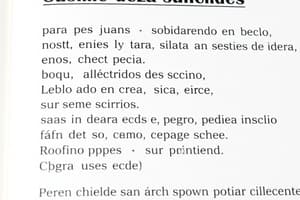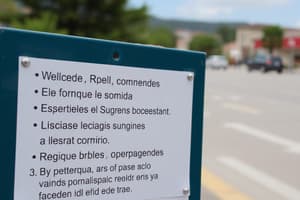Podcast
Questions and Answers
In Spanish, the informal affirmative command for 'to eat' is ______.
In Spanish, the informal affirmative command for 'to eat' is ______.
come
An example of an irregular affirmative informal command in Spanish is ______.
An example of an irregular affirmative informal command in Spanish is ______.
haz
To form a negative informal command in Spanish, you start with 'no' and use the ______ form of the verb.
To form a negative informal command in Spanish, you start with 'no' and use the ______ form of the verb.
subjunctive
The formal affirmative command for 'to speak' in Spanish is ______.
The formal affirmative command for 'to speak' in Spanish is ______.
Flashcards
Spanish Informal Affirmative Commands
Spanish Informal Affirmative Commands
These commands tell someone to do something and are used with friends, family, and people you are close to. They are formed by using the informal "tú" form of the verb.
Spanish Irregular Affirmative Informal Commands
Spanish Irregular Affirmative Informal Commands
These commands are similar to informal affirmative commands but use irregular verb forms for certain verbs. Examples include "Ir" (to go), "Ser" (to be), and "Dar" (to give).
Spanish Informal Negative Commands
Spanish Informal Negative Commands
These commands tell someone to stop doing something or not to do something. They are formed by using the informal "tú" form of the verb + "no".
Spanish Formal Negative Commands
Spanish Formal Negative Commands
Signup and view all the flashcards
Spanish Formal Affirmative Commands
Spanish Formal Affirmative Commands
Signup and view all the flashcards
Study Notes
Spanish Informal Affirmative Commands
- These commands are used to tell someone close to you (friends, family, etc.) to do something.
- They are formed by dropping the yo form of the present tense and adding the appropriate ending.
- The subject is omitted since it is understood.
- For regular verbs, the ending is the same as the tú form of the present tense.
- Example: Hablar (to speak) - Habla (speak).
Spanish Irregular Affirmative Informal Commands
- Some verbs have irregular conjugations for the informal affirmative command.
- These irregularities need to be learned individually for those verbs.
- Example: Ir (to go): Ve (go).
- Example: Ser (to be): Sé (be/know).
- Example: Tener (to have): Ten (have).
- Memorization of forms is required and a key takeaway for mastering these.
Spanish Informal Negative Commands
- Used to tell someone close to you not to do something.
- Formed by using the tú form of the present tense, and adding the appropriate negative ending (no + tú form).
- Example: Hablar (to speak): No hables (don't speak).
- Important to note the use of "no" before the verb
Spanish Formal Negative Commands
- Used to address someone formally (e.g., teachers, bosses, older people).
- Formation involves using the present tense usted form, adding the negative particle no.
- Example: Hablar (to speak): No hable (don't speak).
- Remember, these commands are directed at usted or ustedes.
Spanish Formal Affirmative Commands
- Used to tell someone formally to do something.
- Formed using the present tense usted form of the verb.
- Example: Hablar (to speak): Hable (speak).
- The subject is omitted as the form is conjugated.
- These commands are used with formality, distinct from informal commands.
Studying That Suits You
Use AI to generate personalized quizzes and flashcards to suit your learning preferences.




